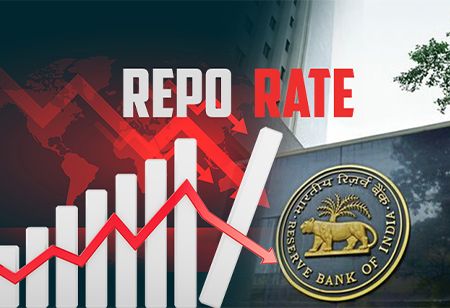During the upcoming Monetary Policy Committee (MPC) meeting scheduled from April 7 to April 9, the Reserve Bank of India (RBI) is set to reduce the long awaited benchmark repo rate. This anticipated policy move is coming at the juncture when the central bank is simultaneously injecting liquidity into the financial system. This move would be to ensure smoother transmission of previous rate cuts. Furthermore, market observers believe the rate reduction could positively steer the country’s economic growth, especially in the face of escalating global uncertainties.
As the global trade is significantly disrupted by US President Donal Trump tariffs, even India is facing the consequences of retaliatory tariffs of up to 27 percent on Indian exports. This geopolitical development has added another layer of uncertainty to an already fragile global economic outlook. Along this, the domestic indicators such as subdued inflation and improved liquidity conditions present the RBI with room to manoeuvre in support of growth
Most of the economists who were surveyed by Bloomberg are expecting the central bank to cut the repo rate by at least 25 basis points (bps). However, there are another section who believes the RBI might consider a slightly deeper cut.
“We expect a 25 bps cut on April 9 and a continuation of the neutral policy stance. However, given the deviation in CPI inflation from RBI’s projection, we believe there is a small but real probability of a 35 bps cut,” highlights Aastha Gudwani, India Chief Economist at Barclays.
CPI Inflation Remains Below Target
If we look at the consumer price index (CPI)-based inflation, it has been easing steadily. In the month of February, it stood at 3.61%, which showcased a drop from 4.26% in January.
A major factor that contributed to this decline was the price mitigation in the food and beverage realm. Also to note, inflation in this category fell from 5.68% the previous month. to 3.84% in February. Vegetable prices, in particular, showcased a sharp reversal - a contraction of 1.07% in February from an 11.35% increase in January.
Hence, allowing it the flexibility to adopt a more accommodative monetary stance, this significant easing in price pressure brings inflation comfortably below the RBI’s medium-term target of 4%.
Robust Liquidity Supports Transmission
The RBI’s active efforts to inject liquidity into the banking system further underline its intention to drive the effectiveness of rate cuts. As per Gaura Sengupta, Chief Economist at IDFC First Bank, the RBI is trying to focus on maintaining a sustained liquidity surplus of 1–2% of Net Demand and Time Liabilities (NDTL) through Q1FY26.
With this surplus liquidity environment at hand, it can aid in strengthening the case for a change in the RBI’s policy stance from ‘neutral’ to ‘accommodative, thereby reinforcing its commitment to supporting economic recovery.
According to Kunal Varma, Co-Founder and CEO at Freo, “As we begin the new fiscal year, the subsequent Monetary Policy Committee (MPC) meeting will be keenly observed for signs on the direction of interest rates. Though inflation seems to be gradually easing, global uncertainties and food price volatility remain on the radar. We do not expect a rate cut in the near term; however, it would not be surprising if the pause extended in a more dovish manner. For borrowers, interest rates can still remain stable in the near term, but the latter half of the year might bring some relief if inflation keeps softening. The attention will still remain focused on growth support while keeping a lid on inflation.”
Bond Yields Reflect Rate Cut Expectations
Another front that has already started factoring in the likelihood of a rate cut is India’s bond market. To crunch on the numbers, bond yields in March fell nearly 20 bps, and in FY25 alone, it decreased over 50 bps. This is the sharpest decline seen in the last five fiscal years. Furthermore, driven by both domestic and international cues, this fall in yields signals growing market confidence in a softer interest rate regime.
Additionally, supporting investment and consumption, lower bond yields are beneficial for the broader economy as it helps in reducing borrowing costs for both entities - government and private sector.
As the global trade is significantly disrupted by US President Donal Trump tariffs, even India is facing the consequences of retaliatory tariffs of up to 27 percent on Indian exports.
Global Factors Favour Monetary Easing
A combination of falling crude oil prices and a weakening US dollar has put the RBI in a favourable position. Looking at these external developments, it has provided additional room to implement interest rate cuts over the coming quarters, going beyond the rate cuts in the month of April.
While pushing down the US bond yields, dollar index, and oil prices, Trump’s announcement of retaliatory tariffs triggered a global market sell-off. These developments are generally positive for emerging markets like India. As a result, analysts forecast a 25–50 bps cut in the April policy review, with a 25 bps reduction seen as the most probable.
Anand Rathi, Co-founder of MIRA Money, remarked, “We expect the RBI to deliver a 25 bps cut in April, marking the second policy decision under Governor Sanjay Malhotra, who already cut rates by 25 bps in February. We see a total reduction of up to 75 bps through FY26.”
He further added, “With US 10-year yields falling to five-month lows, oil prices dropping over 6% amid higher production, and the dollar index sliding below 102, the RBI is well-positioned to continue on its easing path.”
Another factor to consider would be the decrease in oil prices reduces the inflationary pressures and India’s import bill. This will further help in improving the current account balance. At the same time, a weakening dollar is a boon for the rupee as it will reduce the cost of imported goods, directly aiding in mitigating the inflation.
Liquidity Infusion Measures
The RBI’s liquidity measures have been aggressive and sustained. Since January, the central bank has injected nearly ₹6.8 lakh crore through a mix of Open Market Operations (OMOs), Variable Rate Repos (VRRs), and forex swaps. These steps have narrowed the liquidity deficit from ₹2 lakh crore in January to ₹1.6 lakh crore in March.
On April 3, the RBI announced plans to purchase ₹80,000 crore worth of government bonds in April, prompting the benchmark 10-year bond yield to fall sharply to 6.5%. This reinforced market expectations of a rate cut.
Fixed Deposit Rates Begin to Decline
Looking at the current situation, several banks have already started adjusting their fixed deposit (FD) rates downward as they anticipate a further policy rate reduction.
HDFC Bank
HDFC Bank has also revamped its FD rates from April 1, 2025 by offering 3% to 7.25% for regular customers on deposits under INR 3 crore. Adding to this, with the highest rates applicable for tenures between 10 to 21 months, senior citizens now can earn 3.5% to 7.75%.
Yes Bank
Yes Bank has also reduced its FD rates by 25 bps for select tenures. This revised rate for general investors now varies from 3.25% to 7.75%. And if we speak of senior citizens, they can earn 3.75% to 8.25%.
Punjab & Sind Bank
This public sector bank discontinued its 333-day and 555-day FD tenures and reduced rates on other popular tenures. The 444-day FD rate was cut by 20 bps to 7.10%, while the 777-day tenure saw a steep 75 bps reduction to 6.50%.
As per Rohit Garg, CEO and Co-Founder at Olyv, “As the MPC meeting draws near, the fintech industry is keenly watching for signs of a possible rate cut—especially with inflation easing and global economic uncertainties in play. A rate cut could catalyze borrowing, accelerate digital lending, and boost financial inclusion - all of which are key pillars of fintech growth. However, the RBI faces a delicate balance between supporting growth and maintaining financial stability amid global market volatility. For fintechs, lower rates could improve credit accessibility for both consumers and small businesses. That said, we remain cautious of external shocks. The right policy move at this juncture can further digitize India’s financial ecosystem and build long-term resilience.”


